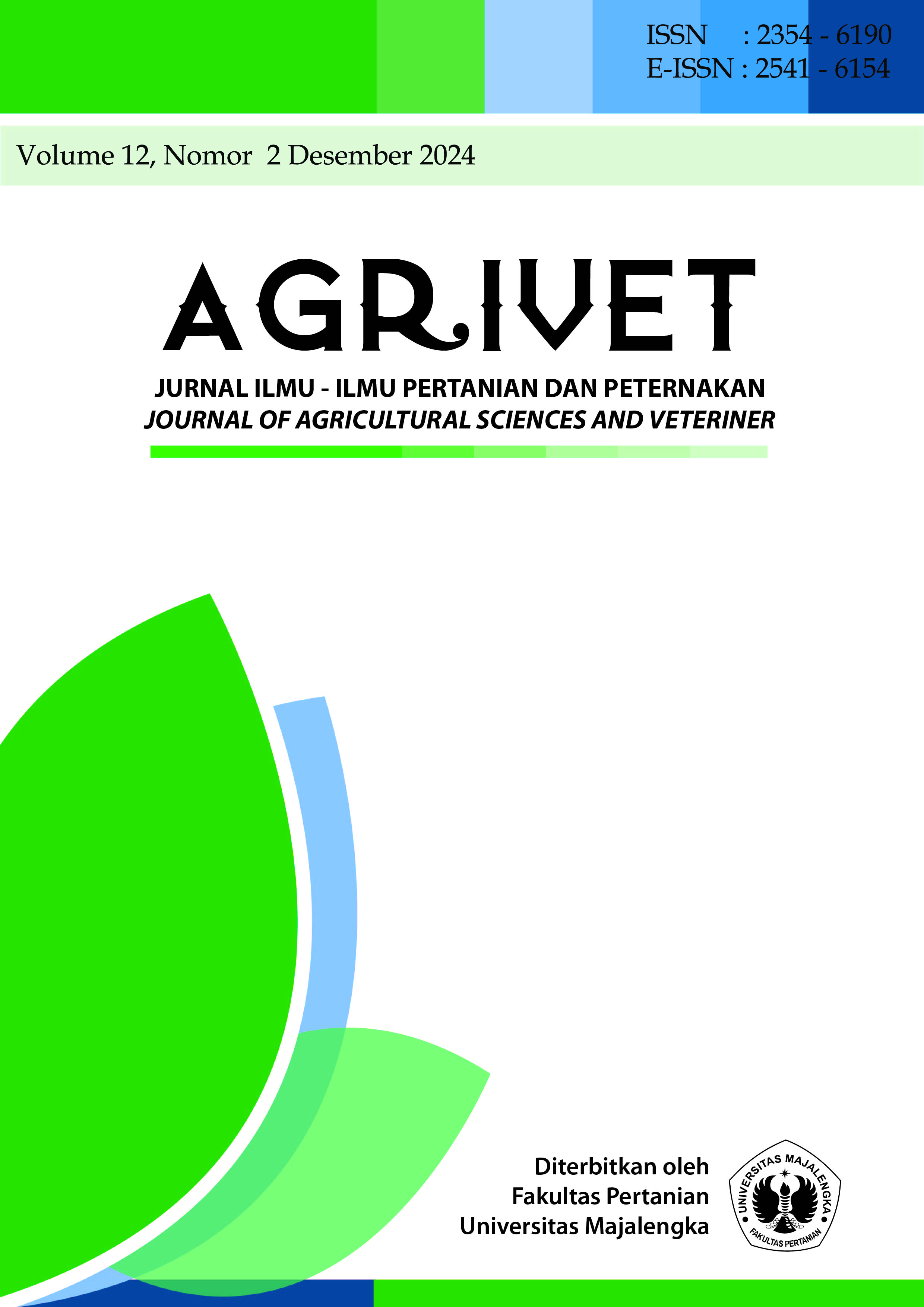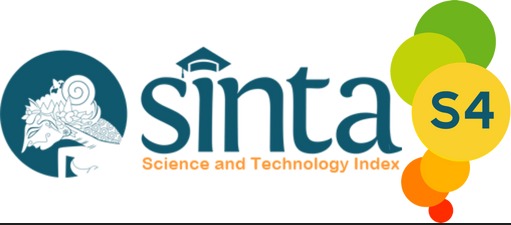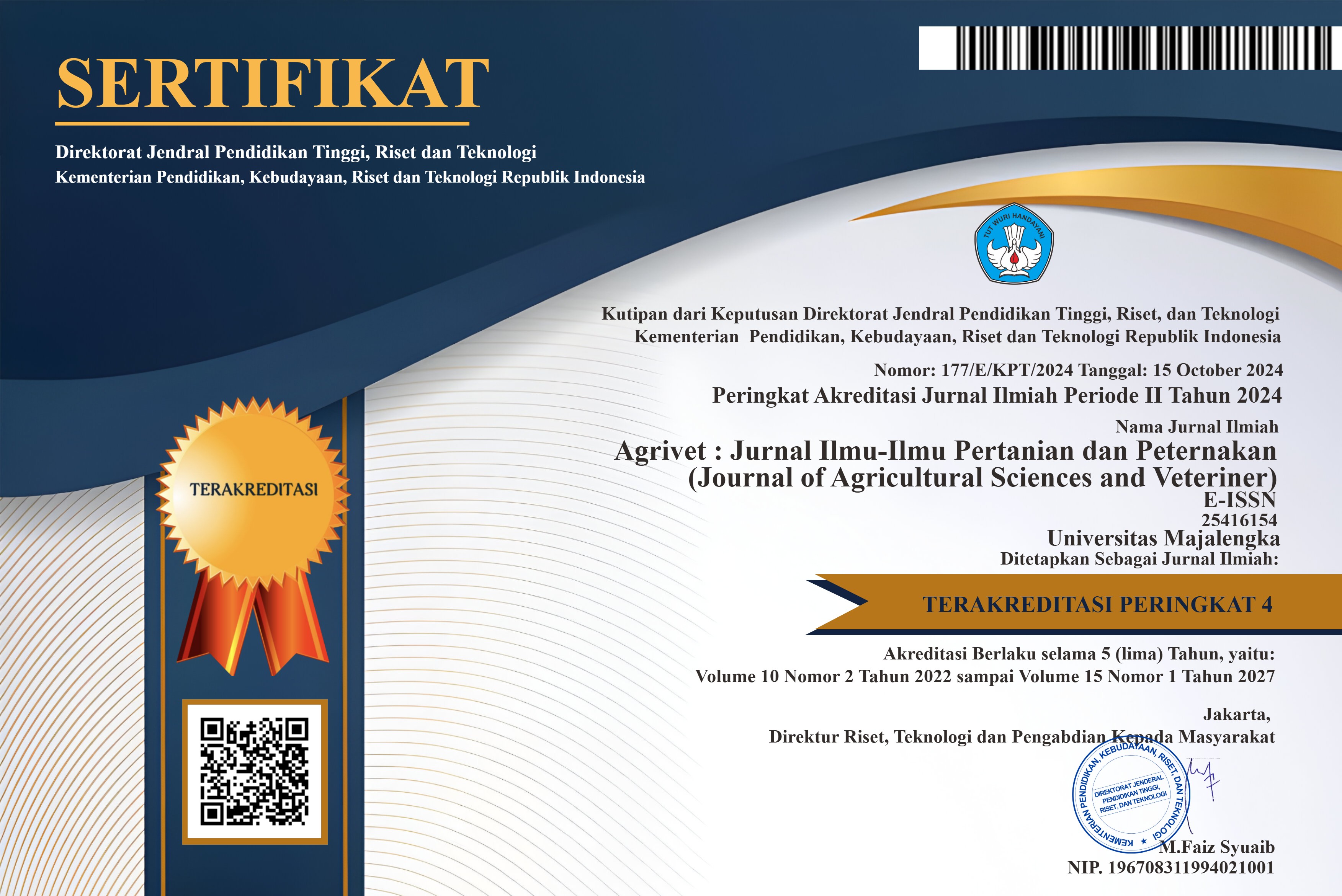Analisis konsentrasi dan kemurnian Deoxyribo Nucleic Acid (DNA) dari rumput pakan ternak
DOI:
https://doi.org/10.31949/agrivet.v12i2.10618Abstract
This research was conducted at the Biotechnology Research and Testing Lab of the Faculty of Animal Husbandry, Padjadjaran University, and the Rice Standard Instrument Testing Center (BBPSI Padi), Subang Regency, West Java starting on September 20 to December 22, 2023. The purpose of this study was to evaluate the effectiveness of the hipure Kit in isolating grass Deoxyribo Nucleic Acid (DNA) by ensuring adequate concentration and cleanliness of samples from contaminants for subsequent molecular applications. The ideal DNA concentration for PCR is 20-50 ng/µL, with an A260/A280 absorbance ratio of about 1.8-2.0 and an A260/A230 ratio above 2.0, indicating the absence of contamination from proteins, salts, carbohydrates, or other organic compounds. The methodology of this study was a descriptive exploration involving descriptive statistical analysis to evaluate the variation in DNA concentration between samples, using spreadsheet software to facilitate data management. The results of the Nanodrop spectrophotometric analysis showed that there variations in DNA concentration between samples, but generally within a range adequate for laboratory applications such as PCR and sequencing. In addition, the HiPure Plant DNA Kit proved effective in producing high-concentration DNA with clear and defined DNA bands in electrophoresis and effectively minimizing contaminants. Further optimization of the extraction protocol, such as adjusting the incubation time or buffer concentration, is recommended to improve DNA concentration and purity. This step will ensure higher DNA quality for downstream applications such as PCR.
Keywords:
concentration, Extraction, DNA, Hi Pure Kit, PurityDownloads
References
Adijaya, N., Yuwono, B. S., & Suharjo, M. (2007). Rumput gajah mini (Pennisetum purpureum cv. Mott) sebagai hijauan pakan ternak. Jurnal Peternakan Indonesia, 12(2), 120-130.
Arfian, R., Hasbi, M., & Sari, D. (2019). Nutritional quality of various forage plants for ruminants. Jurnal Ilmu Ternak dan Veteriner, 24(2), 101-110.
BET. (1997). Rumput Gajah Taiwan (Pennisetum purpureum cv. Taiwan). Bulletin of Animal Husbandry, 5(1), 30-35.
Cappuccino, J. G., & Sherman, N. (2009). Microbiology: A Laboratory Manual. Pearson/Benjamin Cummings.
Chaiyabutr, N., & Juntanawat, W. (2021). Comparative nutritional value of Pakchong grass and other forage species for ruminants. Animal Nutrition and Feed Technology, 21(2), 101-113.
Cherdthong A, Rakwongrit D, Wachirapakorn C, Haitook T, Khantharin S, Tangmutthapattharakun G, Saising T. 2015. Effect of leucaena silage and napier Pakchong 1 silage supplementation on feed intake, rumen ecology and growth performance in Thai native cattle. Khon Kaen Agriculture Journal 43:1:484–490.
Fatchiyah, T., Hudiyono, R., & Raharjo, A. (2011). Teknik dasar dalam biologi molekuler. Jakarta: Penerbit Universitas Indonesia.
Gaffar, H. (2007). Teknik elektroforesis. Jurnal Bioteknologi, 3(2), 55-63.
Green, M. R., & Sambrook, J. (2012). Molecular Cloning: A Laboratory Manual (4th ed.). Cold Spring Harbor Laboratory Press.
Green, R. C., Adams, S. L., & Carter, J. A. (2020). Next-generation sequencing technologies and their applications. Genomics Research, 31(2), 456-468.
Hadi, R., Wahyu, P., & Koesmayadi, A. (2011). Hijauan pakan ternak ruminansia: Kualitas dan pengelolaan. Jurnal Ilmu Ternak, 13(1), 45-53.
Hendarto, D., & Suwarno, E. (2013). Ketersediaan hijauan pakan dalam mendukung produksi ternak ruminansia. Jurnal Agrikultura, 16(2), 101-110.
Herlinae, R. (2003). Nutrisi hijauan pakan untuk ternak ruminansia. Prosiding Seminar Nasional Peternakan, 8(1), 57-62.
Hidayati, N., Sulistyawati, N., & Sari, D. (2016). Teknik ekstraksi DNA menggunakan metode kit komersial. Jurnal Bioteknologi, 23(4), 190-197.
Hikmatyar, M., Rohman, F., & Kurniawati, E. (2015). Evaluasi kemurnian dan konsentrasi DNA menggunakan spektrofotometer UV. Jurnal Sains dan Teknologi, 8(3), 112-117.
Innis, M. A., & Gelfand, D. H. (1990). PCR Protocols: A Guide to Methods and Applications. Academic Press.
Jaelani, A. (2012). Pengaruh pemupukan terhadap produksi rumput gajah mini. Jurnal Agrotropika, 10(1), 75-82.
Junsiri R, Suttibak S. 2016. Effect of reaction temperatures on yields and properties of bio-oil produced by fast pyrolysis of Napier Pak Chong 1 grass (Pennisetum purpureum Schum). Journal of Materials Science and Applied Energy 5 :1: 18-21.
Kathiraser, T., & Mott, G. (2019). Teknik penanaman rumput pakchong. Jurnal Agroforestri, 5(2), 123-130.
Kiyothong, K. (2014). Napier Pakchong: Development and utilization. Journal of Livestock Science, 8(3), 200-210.
Kusumawati, D., Harsono, S., & Setiawan, B. (2018). Annual production and management practices of Pakchong grass in tropical regions. Journal of Tropical Agriculture, 46(2), 145-153.
Lasamadi, E., Sudiyono, A., & Syamsu, J. A. (2013). Hijauan pakan ternak: Teknik pengolahan dan pemanfaatan. Jurnal Teknologi Ternak, 7(2), 99-110.
Latham, K. R. B., Smith, A. M., & Green, R. C. (2018). Optimization of PCR conditions for amplification of specific DNA sequences. Journal of Molecular Biology, 430(4), 1234-1245.
Liman, H., Nugroho, A., & Putra, W. (2021). High production levels and superior nutritional content of Pakchong grass compared to its progenitors. Journal of Animal Feed Science, 29(4), 456-463.
Lorenz, T. C. (2012). Polymerase Chain Reaction: Basic protocol plus troubleshooting and optimization strategies. Journal of Visualized Experiments, (63), e3998.
Maftuchah, R., Rahmawati, E., & Mufidah, T. (2014). Efisiensi metode ekstraksi DNA dari daun tanaman jambu biji. Jurnal Biologi, 10(2), 78-85.
Minarsih, T., Setiawan, B., & Suhartono, M. (2016). Rasio absorbansi sebagai indikator kemurnian DNA. Jurnal Biologi Molekuler, 22(1), 55-62.
Ningsih, E., & Setiana, S. (2011). Peran hijauan pakan dalam meningkatkan produktivitas ternak ruminansia. Jurnal Sains Peternakan, 9(2), 85-95.
Novitasari, D., Suprapto, H., & Yuliani, S. (2014). Pengaruh variasi konsentrasi gel agarosa terhadap hasil elektroforesis DNA. Jurnal Sains dan Teknologi, 12(2), 45-50.
Pediaa. (2023). Differences between agarose and polyacrylamide gels. Retrieved from https://pediaa.com (diakses pada 3 Juni 2024 pada pukul 16.42 WIB)
Pitaksinsuk, T., Smith, J., & Rattanachomphu, S. (2010). High nutritional value and preference of Pennisetum purpureum cv. Thailand for ruminant and non-ruminant livestock. Journal of Agricultural Science, 15(2), 123-130.
Promkhambut, A., Khemwong, R., & Samart, P. (2018). Evaluation of drought resistance and nutritional characteristics of Pakchong grass in comparison to common Pennisetum species. Journal of Animal Science and Technology, 60(2), 305-315.
Purmawangsa, H., & Winiar, H. (2014). Produksi rumput gajah mini pada berbagai kondisi lingkungan. Jurnal Agronomi, 19(1), 67-74.
Puttapong, N., & Sereenonchai, S. (2020). Planting techniques and growth management of Taiwan grass. Forage Science, 36(1), 45-55.
Quantabio. (2023). Guide to DNA extraction protocols. Retrieved from https://quantabio.com (diakses pada 3 Juni 2024 pada pukul 16.42 WIB)
Rini, S., Nugroho, H., & Widyawati, D. (2018). Kajian molekuler untuk perbaikan genetik hijauan pakan ternak. Jurnal Bioteknologi Pertanian, 12(3), 98-107.
Robert, J. D., Simon, A., & Micheal, T. (1999). Penggunaan isoamil alkohol dalam ekstraksi DNA. Journal of Molecular Biology, 25(4), 215-225.
Rukmana, R. (2005). Budidaya rumput gajah mini. Yogyakarta: Kanisius.
Sakadoci, N. (2019). Teknik penanaman dan pemeliharaan rumput pakchong. Journal of Agricultural Science, 15(2), 170-180.
Samarawickrama, R., Seneviratne, P., & Perera, S. (2018). Adaptasi rumput pakchong pada berbagai kondisi agroekologi. Journal of Tropical Agriculture, 11(1), 88-95.
Sambrook, J., & Russell, D. W. (2001). Molecular Cloning: A Laboratory Manual (3rd ed.). Cold Spring Harbor Laboratory Press.
Sari, D., Nurhadi, N., & Wijayanto, M. (2020). Assessment of metabolizable energy content in various forage species. Animal Feed Science and Technology, 269, 114-124.
Sarian, B. (2013). Renewable energy and high-quality forage from Pennisetum purpureum cv. Thailand. Agricultural Research Journal, 22(3), 345-351.
Sarian, B. (2013). Rerumputan Pakchong sebagai sumber energi terbarukan. Jurnal Sumber Daya Alam, 8(2), 105-115.
Shen, Y., Li, J., Zhang, D., Zhao, Y., & Hou, T. (2018). Recent advances in DNA detection techniques. Trends in Analytical Chemistry, 107, 213-223.
Sirait, A., Sunaryo, S., & Riyadi, S. (2005). Konsumsi pakan ternak ruminansia. Jurnal Ilmu Nutrisi Ternak, 11(1), 33-42.
Sirait, S. (2014). Kandungan nutrisi rumput gajah mini. Jurnal Ilmu Peternakan, 9(1), 115-123.
Siregar, I. (1996). Analisis nutrisi rumput gajah Taiwan. Jurnal Nutrisi dan Makanan Ternak, 4(1), 55-65.
Sirisopapong, S. (2015). Kandungan gizi rumput pakchong. Journal of Agricultural Science, 17(4), 230-240.
Smith, A. M., Brown, J. D., & Johnson, P. L. (2016). Quantitative gel electrophoresis of DNA. Analytical Biochemistry, 505, 72-80.
Somsiri, S., & Vivanpatarakij, P. (2015). Pengembangan rumput pakchong di Thailand. Journal of Livestock Development, 10(1), 150-160.
Suherman, D., & Herdiawan, I. (2021). Karakteristik produktivitas dan pemanfaatan rumput gajah hibrida (Pennisetum purpureum cv. Thailand) sebagai hijauan pakan ternak. Jurnal Ilmu-Ilmu Peternakan, 6(1), 37-45
Suherman, R., & Herdiawan, H. (2021). Kandungan gizi rumput pakchong. Jurnal Nutrisi Ternak, 13(3), 200-210.
Suryo, S. (2012). Prinsip dasar ekstraksi DNA. Jurnal Bioteknologi, 18(2), 77-85.
Surzycki, S. (2000). Proses pengendapan DNA dengan etanol. Journal of Molecular Techniques, 22(3), 145-155.
Suyitman, S. (2014). Produksi dan kualitas nutrisi rumput raja. Jurnal Peternakan, 19(1), 90-98.
Suyitman, S., Setiawan, A., & Haryanto, B. (2003). Budidaya rumput raja untuk produksi pakan ternak. Jurnal Agroindustri, 8(1), 55-60.
Syarifuddin, A. (2006). Morfologi dan produksi rumput gajah mini. Jurnal Agrikultura, 10(2), 65-75.
Tan, S. C., & Yiap, B. C. (2009). DNA, RNA, and protein extraction: The past and the present. Journal of Biomedicine and Biotechnology, 2009, 1-10.
Tenriolu, A. (2016). Prosedur ekstraksi DNA dari tanaman. Journal of Biotechnology, 25(1), 98-105.
Thermo Fisher Scientific - US. (n.d.). Gel electrophoresis for nucleic acid separation. Retrieved from https://www.thermofisher.com (diakses pada 3 Juni 2024 pada pukul 18.00 WIB)
Triwibowo, E. (2008). Elektroforesis untuk analisis DNA. Jurnal Kimia dan Bioteknologi, 5(1), 20-25.
Varma, A., Kumar, R., & Singh, B. (2007). Faktor-faktor yang mempengaruhi keberhasilan ekstraksi DNA. Journal of Molecular Biology, 30(2), 145-155.
Vivikananda, M. (2014). Penggunaan elektroforesis dalam analisis genetik. Jurnal Bioteknologi, 6(2), 34-40.
Winarno, F. G., & Agustinah, L. (2007). Prinsip dasar elektroforesis. Jurnal Teknologi Laboratorium, 1(1), 10-15.
Yuliana, S., Nugroho, H., & Santoso, T. (2019). Digestibility and feeding value of Odot grass (Pennisetum purpureum cv. Mott) for cattle. Animal Feed Science and Technology, 251, 115-124.
Yuwono, T. (2005). Elektroforesis gel dalam analisis biologi molekuler. Jurnal Bioteknologi, 2(3), 76-83.
Published
How to Cite
Issue
Section
License
Copyright (c) 2024 Syafiradewi Yulianti, Romi Zamhir Islami, Mansyur, Estria Furry Pramudyawardani

This work is licensed under a Creative Commons Attribution-ShareAlike 4.0 International License.
An author who publishes in the Jurnal Agrivet agrees to the following terms:
- Author retains the copyright and grants the journal the right of first publication of the work simultaneously licensed under the Creative Commons Attribution-ShareAlike 4.0 License that allows others to share the work with an acknowledgment of the work's authorship and initial publication in this journal
- The author is able to enter into separate, additional contractual arrangements for the non-exclusive distribution of the journal's published version of the work (e.g., post it to an institutional repository or publish it in a book) with the acknowledgment of its initial publication in this journal.
- The author is permitted and encouraged to post his/her work online (e.g., in institutional repositories or on their website) prior to and during the submission process, as it can lead to productive exchanges, as well as earlier and greater citation of the published work












